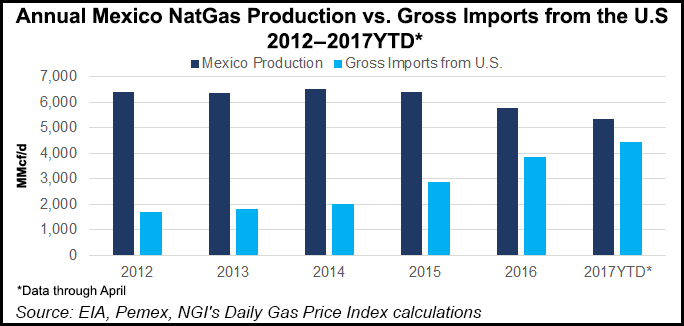Markets | Mexico | NGI All News Access | NGI Mexico GPI | NGI The Weekly Gas Market Report
Mexico’s Open Capacity Natural Gas Market Off to Smooth Start, Cenagas Says
The first days of operations under Mexico’s new natural gas capacity reservation system have gone relatively smoothly, according to pipeline system operator Centro Nacional de Control del Gas Natural (Cenagas).

In general, the market “has been functioning quite well, and we’ve managed to get through it without any operational snags,” Cenagas director David Madero told NGI last Friday. “Of course, it’s a transitional phase. We’ve been working with all the participants who want to make nominations and receive services, so that they can get used to the new way of operating.”
On July 1, Mexico’s energy regulator, the Comision Reguladora de Energia (CRE), began enforcing the capacity-based contracting model, implemented as part of the country’s efforts to liberalize its natural gas market. Cenagas in May awarded the first contracts with one-year terms via an open season for domestic pipeline capacity on the Integrated Natural Gas Transport and Storage System (Sistrangas).
The new market model is expected to present a steep learning curve for participants, particularly among smaller players. Cenagas held three rounds of training sessions for its clients ahead of the July 1 start date.
“It’s a continuous process that we are carrying out with all of them, so that any problems they may have when operating under the new regime and using the new software…are as minimal as possible,” Madero said.
Moreover, although July 1 marked an important move toward open competition, the Mexican natural gas market remains in a fledgling state.
“It’s the first step in what will logically be a very prolonged process,” Fermaca’s Raul Monteforte, chief development officer at the private pipeline developer, told NGI. “Our market is still very incipient. Little by little, we will have to go through additional phases of liberalization, the acceleration and deepening of open access, [and] the release of state-held marketing portfolios to agents in the competitive market.”
Mexico’s first open season and the subsequent implementation of its capacity reservation system have allowed new shippers to enter the transportation market, but government-owned firms remain dominant players.
Last October, the Mexican government held a closed Round 0 to assign pipeline capacity for the operations of its state enterprises. National oil company Petroleos Mexicanos (Pemex), state power utility Comision Federal de Electricidad (CFE) and independent power producers (IPPs), which sell electricity to CFE through long-term contracts, picked up 4 Bcf/d of capacity.
This left only 2.2 Bcf/d available in the 6.2 Bcf/d Sistrangas system for the open season in May. In that auction, 24 private companies won 41% of the capacity on offer, while the remaining 59% went to a Pemex subsidiary.
It will also take time for a secondary market to emerge where companies may buy and sell excess transportation capacity. After the open season concluded, participants were allowed to swap capacity, in what amounted to a practice run for a secondary market, Madero said.
The terms and conditions for Cenagas in its role as technical operator of Sistrangas, which CRE approved in 2016, also include some provisions on capacity release mechanisms, but these are too rigid for a full-fledged secondary market to develop, according to Cenegas’ Eduardo Prud’homme, head of the planning and technical unit.
As such, the operator and the regulator are working in parallel to develop, respectively, a platform and the operational rules for the secondary capacity market.
“We meet with the CRE every week,” Prud’homme told NGI. “The problem is that the regulatory agenda is very packed and the subjects to address are quite broad.”
“The secondary market is very important, but for now we don’t have a finished draft” of the rules, he said. “And obviously since this will be a regulated process, the draft will have to go through a public consultation. So it will take a few months.”
© 2024 Natural Gas Intelligence. All rights reserved.
ISSN © 1532-1231 | ISSN © 2577-9877 | ISSN © 2577-9966 | ISSN © 1532-1266 |
